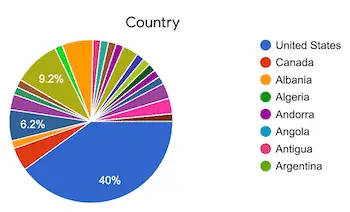In this article, I’ll be outlining the popularity of tea in America as it is now and as it once was, specifically in North America, USA. Including statistics, and real-world results from the Teahow Global Tea survey. We’ll be finding out – is tea popular in America?
But first, here’s the quick takeaway, then we’ll get into more details…
The USA ranks 35th out of the top 55 tea-drinking nations. Popularity has risen over recent decades, as 0.79 lb of tea per citizen drank per annum, compared to 0.48 lb per capita at the time of the Boston Tea Party (1773). Black sweet tea served cold, is the most popular type of tea in America.
Is tea popular in America
According to the top 55 tea-drinking nations arranged in order of volume of tea per capita, The USA is sitting at 35th position, nestled between Finland (34) and Argentine (36).
In the late 1700s, the British tea tax, revolutionary rebellious acts, politics, economics, and boycotts all served to reduce the popularity of tea… and saw the rise of coffee as the new mainstay in hot beverages in North America. But what about now? Is Tea popular in America?
And, how popular is tea in America – as of now? Let’s get into that first so we can answer questions about its current popularity. Then we’ll dive into how we got to this point…
Current tea popularity in Modern America
Currently, tea is still consumed in great quantities in the USA. Statistics report that in 2019 (most recent results), Americans consumed over 84 billion servings of tea – more than 3.8 billion gallons.
Here we can take the year at which tea taxation was introduced that began the decline of tea consumption, and compare it to how consumption has grown today.
So, when we compare the current pounds per annum, against pounds per annum in 1773, on a per capita basis, we can see that tea in fact has greater popularity now than it was in 1773.
| 1773 | 2019 | |
|---|---|---|
| American Population | 2.5 million | 328 million |
| Imports of Tea (lb) | 1.2 million | 260 million |
| Annual consumption per capita | 0.48 lb | 0.79 lb |
The net result is that the average US American today now consumes 64% more tea than they did 246 years ago. Modern living …which includes healthier lifestyle choices, plays a large role in this.
So, since the defining act of the Boston tea party in 1773, tea has gradually increased and surpassed previous figures for popularity in America.
Current tea survey results
Results accrued from my ongoing global tea survey, available to over 120 countries, indicate some interesting statistics – based largely on respondents in the US that drink tea.
Of the respondents that have contributed to the survey thus far, the results included a roughly even split of male to female, and a spread of age groups as defined below.
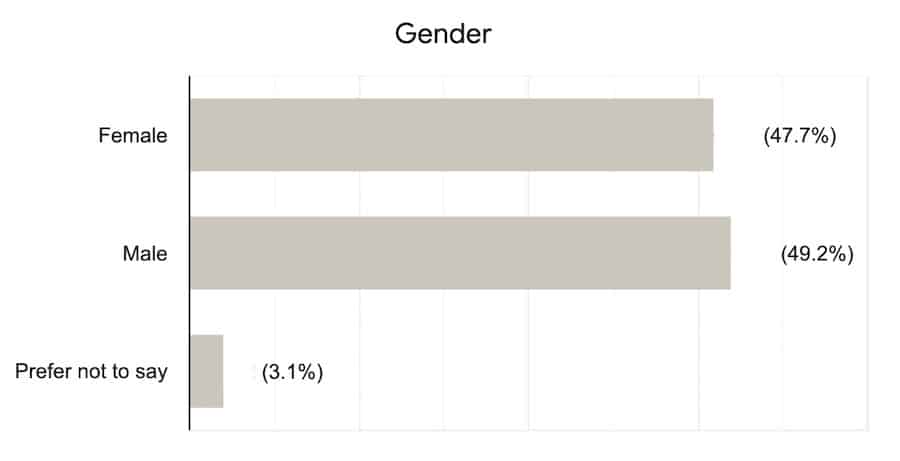
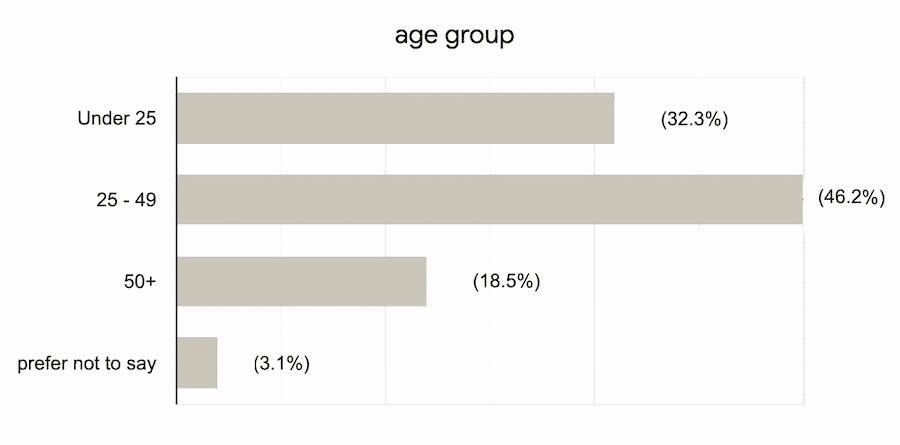
Of the respondents, 40% were from the US. Representing the largest portion by some margin.

In the survey, black tea leads the way with 64.1% of respondents selecting black tea as their most preferred drink.
Followed closely by Green tea at 59.4% (respondents could select multiple options)
This again is roughly in line with national statistics, which show that:
- 84% of tea consumed in the USA was black tea
- 15% was green Tea
- Smaller figures remaining to be oolong, white and dark tea
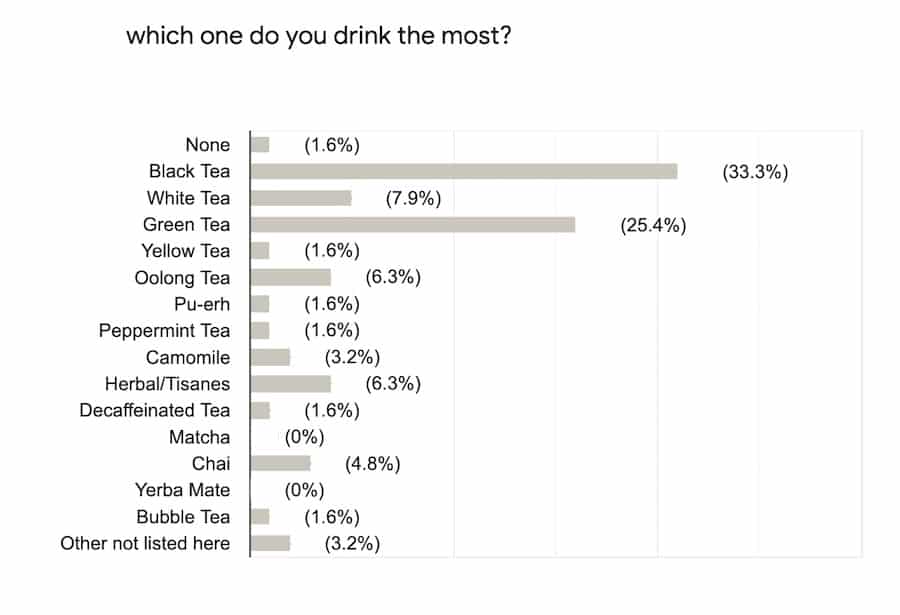
The large percentage of black tea popularity is historically linked to iced tea being popular as a US beverage, particularly in the Southern United States.
Green tea had actually increased its percentage of total imports in 2019 over the previous year, which echoes the growing trend in green tea and health benefits.
Add your own response to the ongoing global tea survey to then see the full results. And a chance to win a copy of my Tea Sommelier Course!
The United States vs Worldwide tea trend
For a modern way of gauging trends, we can look to Google, internet searches can provide a vast sample of search data and Google trends provides this data for tea – as a beverage, since 2004 – when Google began recorded search data trend.
When we compare the trend of tea in America, vs the trend on a worldwide scale, we can see that the USA is indeed growing in tea popularity, roughly in line with the worldwide trend.
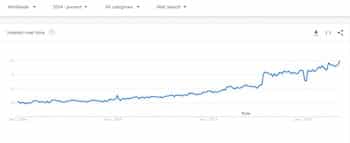
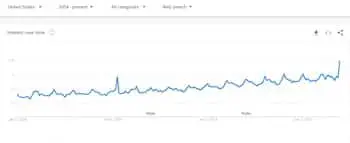
So how did tea go from the second largest (after water) to the third-largest consumed beverage in North America? Let’s look at the pivotal points in history affecting the popularity of tea in America.
The period of decline in tea popularity in America
On April 27, 1773, the failing East India Company was granted sole tea supply rights to North America.
This ignited a chain of events that would see 342 chests of tea being thrown overboard by the Boston Tea Party, increased powers given to the Massachusetts governor, and even involve the deployment of British troops.
To understand the flow of popularity of tea in America, we also need to explore a bit of American tea history to help us understand how we arrived at today…
Tea is less popular than coffee in America
It may surprise you to think of America as being a former nation fully entrenched in the tea culture.
Americans indeed loved tea and it was considered the all-day, everyday beverage during the 1600 and 1700s. in much the same way as coffee is considered to be in modern America.
Tea was, at that time, as important to American routine and culture, as it was to the English.
It took a series of events for America to dramatically lose its taste for tea (pun intended!) and the culture that went with it.
This eventually led to the dominance of coffee in modern America.
Tea taxes
The British decided to impose a series of taxes on the American colonies to assist them in reducing their debts to the British empire.
From the stamp taxes that started in 1765 that imposed taxes on every piece of printed paper, to the 1767 Townshend Acts that went further to impose taxes on paint, paper, glass, lead, and tea.
The Americans, who had no representation in the British parliament, were furious about these taxes, believing them to be unjust.
However, the British government felt these taxes were fair in order to compensate them for the debts earned fighting wars on behalf of the American colonies.
In fact, so popular was tea in America, that the British eventually repealed taxes imposed on all other commodities – except for tea.
This is because tea was such a popular beverage that it provided a large tax revenue for the 1.2 million pounds of tea the Americans consumed every year.
This heavy tax contributed to a steep downturn in the American tea trade.
Coffee became the alternative to tea
It’s following the onset of these taxes that Americans began looking for an alternative to replace their daily cup of tea, that coffee started to emerge as a viable option.
It was during this time, that outraged Americans boycotted tea sold by the British East India Company.
This boycott movement occurred between 1773 (The event of the Boston tea party) and the end of the revolutionary war in 1783.
Over this 10 year period, Americans gradually lost their taste for tea – pun intended. The declining period allowed sufficient time for coffee to take a dominant place over tea.
As such, tea consumption gradually faded from the American daily lifestyle, its popularity diminishing over the course of at least a century.
These seemingly unjust events – and the ensuing revolutionary movements, therefore, led to several cultural controversies when America gained independence from the British empire.
Tea almost became a “guilt-laden” beverage for many Americans.
Reasons for the reduction in tea popularity in America
Below are three reasons why tea’s popularity in America constantly faced gradual downfall, giving the rival of coffee its prominence that remains to date.
1. John Adams declared tea a “traitor’s drink”
Following the Boston tea party and the revolutionary movement John Adams, the second president of the US declared tea to be a traitor’s drink.
This placed an informal boycott on tea throughout the British colonies.
This movement spread throughout all the colonies, and people began replacing tea with coffee within their daily lifestyle.
This extended to people uniting and vowing to only serve coffee at home. Drinking tea was now viewed as an act of betrayal to the colonies.
2. American fear of product contamination
In the 18th and 19th-century tea was still a popular beverage… even in America.
However, smallpox became a major reason for deaths in America and it was believed that this contamination came from imports.
Since the Americans at that time were still major importers of tea from China, they believed this contamination came mainly from Chinese tea, and fear for tea developed ever since then.
This also greatly influenced the Americans to switch to coffee from tea, and thereby the popularity of tea was once again took a major hit. Here’s the comparison between black tea and black coffee!
Historical signs of this feat still remain today. Strong enough that even to this day, many Americans fear contamination and infection from Chinese products.
3. Tea became stereotypically feminine in America
In the 20th century, tea began slowly gaining momentum back from its lost popularity. Starting with the growing trend of tea rooms.
These rooms were regularly occupied by women and were often run by women too.
Tea rooms often sported largely feminine decor, pink soft furnishings, doilies, and decorative cups.
Tea houses very much emulated a feminine style and nature, including different kinds of dainty, sugary foods were served of which tea was a special delicacy.
The air of feminine attraction that tea developed in these rooms meant that invariably they were frequente4d mostly by women.
This subconsciously marketed tea as being more of a feminine drink in the US.
Men became largely excluded from the association with the tea market, and it soon became a stigma to masculinity, thereby reducing the popularity of tea in America.
This is also where coffee rose to become the main drink for males and for general Americans.
With that background, it would be wrong to say that tea was once popular in America. as it has grown in popularity a number of times before suffering setbacks.
Moving back to the present, tea is indeed popular in America…
But even though tea consumption per capita has exceeded what it once was, it is still not as popular as coffee is now, and coffee will likely remain in a stable first place within the American lifestyle for the foreseeable future.
What kind of tea is popular in America now?
As I indicated earlier, black tea is the most popular tea in America. Black tea accounts for more than half of all the tea consumed in America.
Black tea is followed by green, and fruit or herbal tea. However, since 2000 even black tea consumption has seen some reductions.
While that’s regarding the general American populace, the type of tea popular among Americans can depend further on the individual states or regions.
For example, sweet black tea is cultural in the southern parts of the US. Whereas in Utah, herbal teas are popular. This is often because of Mormon Church influences, which has controversies for black and green tea.
On the other hand in the eastern states of the US, Americans prefer tea types with higher caffeine content.
It should also be mentioned that in some US states with Asian influences, Americans prefer more green tea. Likewise, the type of tea popular in some states of the US is influenced by subcultures.
Iced tea is very popular in America
However, one common thing that can be generalized about what kind of tea is popular in America is iced tea.
Iced tea is so popular in America, that you can find a can of iced tea in pretty much any grocery store. To many Americans, iced tea is the way you should have tea.
In some Southern states of the US, tea is always taken chilled. On the other hand, some states prefer having tea only as a cold drink during summer.
Along the same lines of discussion, sweet tea is the most popular way to have tea in America.
Meaning Americans want their tea to be sweet …like really sweet.
This could be sweet tea with sugar or any other sweeteners. A plain brew with no sugar at all is not so popular in America.
This falls in line with the fact that America consumes the most amount of sugar of any country in the world.
Is tea popular in ceremonial and formal events in America?
Not at all, tea is almost never seen as a formal or ceremonial drink in America.
This place of a formal and ceremonious drink is taken by alcohol or perhaps even coffee – but certainly not tea. This may seem strange, as the making of tea certainly has many more ceremonial aspects to it than coffee. In fact, some cultures take tea ceremonies to a whole new level…
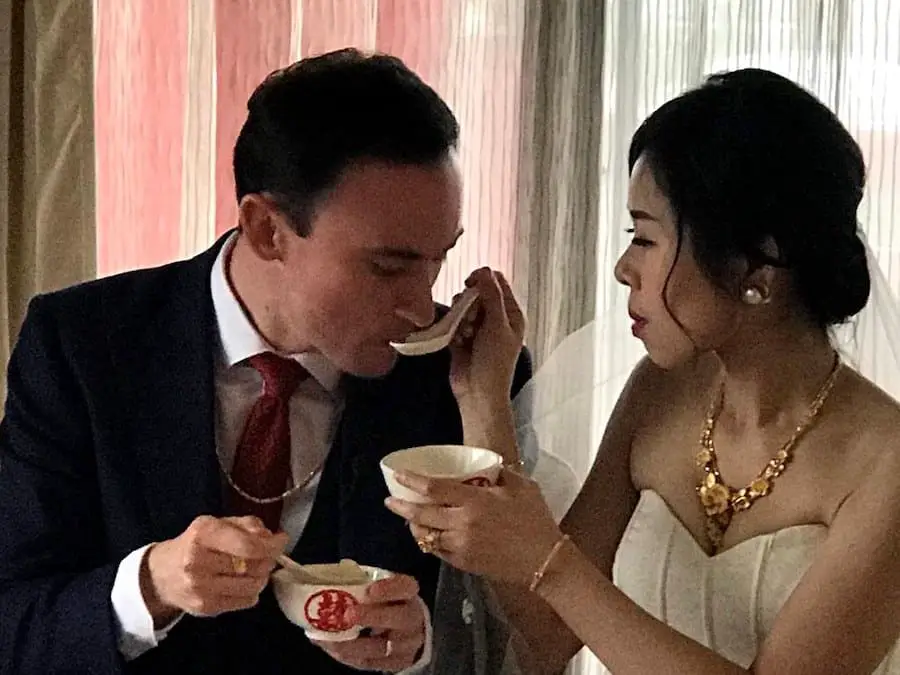
Although the exact reason for this is not known, many Americans see coffee as more of a solitary drink that fits their individualistic culture, whereas tea is seen as a social drink.
In a largely fast paced America, tea is seen as a long, complex, and time-consuming drink. One that slows down a persons routine or daily life.
Starting from the steeping time tea required. Through the need to dispose of tea bags or tea leaves… everything about tea is seen as a time-killing for the rushing American lifestyle. Even though for most tea making this in fact a myth.
This is also why many Americans use teabags over tea leaves, because it’s considered a more time-consuming to brew.
The reason why iced teas are sold in cans is also to fit the fast food American lifestyle. See also my 100 facts about tea.
However, America is a “nation of nations” with a diverse multicultural base. So, depending on the cultural influences within each state, tea could become a part of formal or ceremonial occasions, but for most Americans, it’s just unlikely to feature as such.
To finish up…
So, although tea may be a part of the American lifestyle, and has varying popularity throughout different states. It’s not as popular as coffee …which spans almost every American state… and where you can find a starbucks on virtually every corner!
Don’t forget to enter my ongoing Global Tea survey. Also, check out my tea-wares …and consider elevating your tea skills with my Tea Connoisseur course!
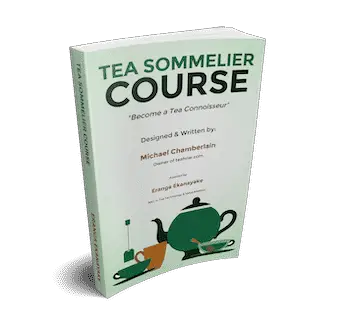
Take the fast track and become a tea connoisseur
Whether for enjoyment or considering a career as a tea sommelier. This course has everything you need to enhance your tea knowledge and tea-tasting skills.
This course keeps it simple with step-by-step tea tasting and easy reference guides
For pleasure, or as a precursor to a career in the tea industry. Find out what tea sommelier actually does, their career paths, and what they earn.

Find out more about the Teahow Tea Sommelier Course!
Find out more about the Teahow Tea Sommelier Course!
